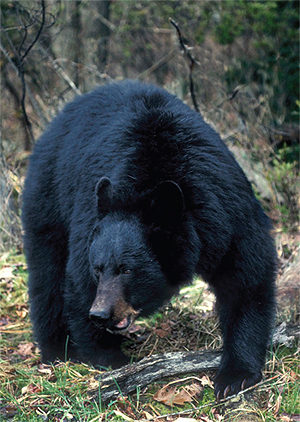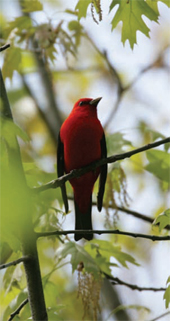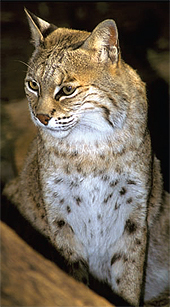Rediscover Bear Run on a Wildlife Walk

Black bears are among Bear Run’s many inhabitants.
Photo courtesy of Pennsylvania Game Commission
(PGC)/ Hal Korber
While Bear Run Nature Reserve is famous as the home of Fallingwater, the 5,000-acre property in the mountains of Fayette County also is home to a wealth of wildlife. WPC staff members are finalizing plans to introduce more visitors to its diverse flora and fauna — including hemlock and oaks, a stunning array of birds, and even bobcats.
The reserve’s 20-mile trail system is being redesigned this winter, with improvements slated to begin in the summer of 2010.
“People who come to tour the house discover it’s surrounded by thousands of acres of largely unfragmented, intact forest,” said WPC’s land stewardship coordinator Andrew Zadnik. “We’d like them to explore the reserve and have a good experience. But, our trail system is 40 years old, and after decades of use we need to make some changes so it will be more accessible, can be sustainably managed by staff and volunteers, and will have minimal impact on the environment.”
Private support from individuals and a $55,000 grant from the Pennsylvania Department of Conservation and Natural Resources will defray some of the cost of the project, which will include erosion control, trail marking and possible relocation, and the development of user-friendly maps.

A scarlet tanager.
Photo by Hays Cummins
Miami University
The renovation is part of a comprehensive conservation plan established for Bear Run — WPC’s largest, flagship property — in 2007, the same year a breeding bird survey of the reserve was completed. It identified 53 species, including Swainson’s warbler, a secretive songbird that inhabits rhododendron thickets and is one of the most sought-after species for the Pennsylvania Breeding Bird Atlas. Although not known to reproduce in the Commonwealth, a singing male was sighted along Laurel Run trail. Also observed were ovenbird, red-eyed vireo, scarlet tanager, wood thrush, hooded warbler, Kentucky warbler, blackthroated green warbler, black-throated blue warbler, black-and-white warbler, Louisiana waterthrush, blue-headed vireo, yellow-throated vireo, rose-breasted grosbeak, broad-winged hawk and many other neotropical migrant species that spend spring and summer in Appalachia and winter in Central and South America.
“The forest is one of the reserve’s three major habitats that support wildlife. Streams and related habitats, such as sandstone cliffs and seeps, are the others,” said WPC Senior Conservation Science Director Charles Bier. “The larger and more intact a forest is, the better.”
The stream valleys contain young and ancient hemlocks as well as rhododendron thickets. The higher elevations support a forest of oak, cherry, beech and maple. Bier noted that the reserve’s extensive, mature forest cover may account for fewer white-tailed deer than in other parts of the state, while contributing to an expanding population of fishers and healthy numbers of black bears, bobcats and barred owls.
Habitats such as cliffs harbor copperhead snakes — a “watch list species” — and the state-threatened Allegheny woodrat, a native more closely related to pack rats out West than old-world rodents reviled by urban dwellers. “It is unfortunate that ‘rat’ is in the name of this animal as it puts the species in a bad place with the public,” said Bier. “Some people have actually proposed changing the common name. ‘Rock chinchilla’ or ‘woods chinchilla’ have been suggested — with some jest.”

Hikers at Bear Run may spot a bobcat.
Photo by Hays Cummins
Miami University
One of the reserve’s most prized features is Bear Run, an Exceptional Value stream and a Pennsylvania Wild and Scenic River stream that supports wild brook trout and other aquatic life. Two dams were removed by hand from Bear Run recently to enhance aquatic movement upstream and downstream.
Anglers, hunters and wildlife-watchers are frequent visitors to Bear Run. Primitive camping is allowed, too, on a first-come, first-served basis. And while most visitors respect the resource, unlawful use of ATVs has become a land management challenge in recent years. “Much of the trail erosion we see is a direct result of ATV use,” said Zadnik. “We’re hoping trail renovations will heighten awareness that four-wheelers aren’t permitted on the reserve.”
For a while, dumpster-diving bears were also a nuisance until Fallingwater maintenance manager Jim Martin and his crew designed a baffler with sheet metal and rebar that thwarted their nighttime food raids. “It fits right over the dumpsters and works in a way that mothballs and other old-fashioned remedies didn’t,” said Martin. “We haven’t had a problem since.”
